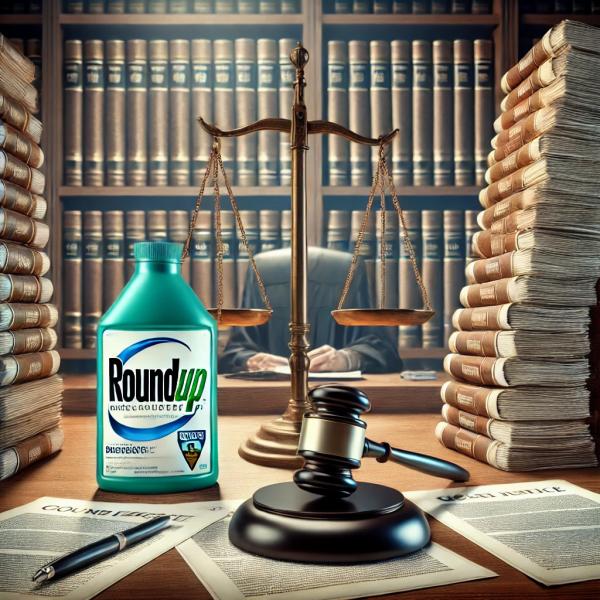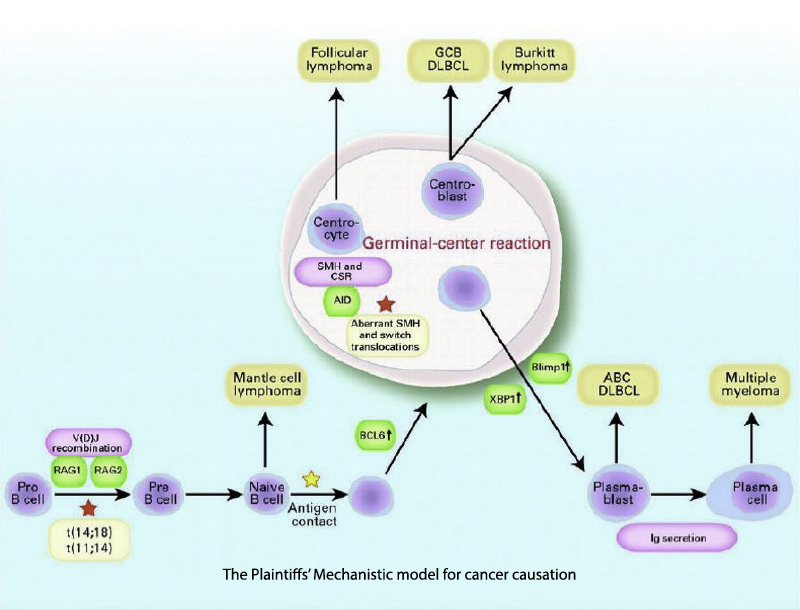
This past July 24, Judge Michael Lee ruled on the carcinogenicity of RoundUp in a class action involving over 20,000 plaintiffs. The hearing on general causation, “whether use of or exposure to Roundup products which contained glyphosate increases risk of developing non-Hodgkin lymphoma (NHL),” took six weeks. The judge tried to convince the parties to utilize alternatives to judicial determination, including special referees with expertise in various fields to make recommendations to the court. Both parties objected.
Reluctantly, the court relented, influenced by the “scandalous allegations” made by the lead plaintiff, Kelvin McNickle, a sympathetic 42-year-old, first exposed to the glyphosate-based weed killer as a youth assisting his dad in his vegetation management business. Even after maturing, marrying, and leaving home, Kelvin’s exposure continued as he volunteered to maintain the lawns and gardens of the Kingdom Hall of Jehovah’s Witnesses. Six years ago, he was diagnosed with Non-Hodgkin’s Lymphoma (NHL), which he claims was caused by his RoundUp exposure.
The devout Mr. McNickle brought this action on behalf of himself and similar occupationally exposed workers, alleging, amongst other claims, that Monsanto had skewed or manipulated prevailing scientific opinion concerning RoundUp’s carcinogenicity.
“I concluded that the risk of referees assessing material said to be infected by this allegation of scientific manipulation created a prospect of complicating the inquiry process.” – Judge Michael Lee
The RoundUp status in the US is in flux. One plaintiffs’ website discloses that on August 20 a trial against Monsanto began in Pennsylvania and that 54,000 cases have yet to be resolved. The site discloses a “major win” by Bayer on labeling requirements and that the plaintiffs lost their motion for a new trial in a Pennsylvania case which they had lost. No mention was made of the McNickle case. Perhaps because it was brought in Australia?
From a legal standpoint, the evidentiary laws Down Under differ from ours (for one thing, they are more beneficial to the plaintiff). But shouldn’t the science be the same globally? In fact, most of the expert witnesses were American (many are veterans of American RoundUp lawsuits; Monsanto even dragged out the 85-year-old Dr. Kenny Crump (of asbestos-litigation fame)), and the major epidemiological study, the Agricultural Health Study (AHS), relied on work by our National Cancer Institute. Since Judge Lee considered all possible mechanisms for proving carcinogenicity, one would think his decision should be influential, if not determinative, in US courts. So far, the McNickle noteworthy decision is too new to have an impact.
Judge Lee’s remarkable 287-page decision reviews:
- the testimony of ten experts (plus the plaintiffs’ shout-out to the disgraced ex-doctor Mark Geier of anti-vax fame),
- 16 epidemiological studies (six case-control, four miscellaneous, and two cohort studies),
- 13 toxicological studies (both in vivo - and in vitro),
- four mechanistic studies detailing ten hypothesized biological mechanisms theorized to cause cancer.
Mechanistic evidence is not considered in US courts as too remote and theoretical. Judge Lee recognizes this but evaluates it nonetheless, although noting:
“as Monsanto was wont to emphasize [sic] … it is not enough to persuade the Court that glyphosate and/or GBFs might cause or increase the risk of NHL – actual persuasion necessitates more: namely, that the Court be reasonably satisfied that glyphosate and/or GBFs are capable of causing NHL in humans.” [emphasis added]
The judge then evaluates the statistical significance (confidence intervals and p-values), differentiates between odds ratios and relative risks, elucidates on case-control versus cohort studies, introduces us to dose-response and the ten Key Characteristics of Cancer [1], and identifies the weaknesses of various toxicological tests. He also alerts us to the dangers of misclassification in epidemiological studies, along with recall bias. In short, the opinion is a primer on the legal science of causation.
He then evaluates the evidence according to the weight-of-the-evidence model. This method is no longer the initial determinator in American Courts per the amended Federal Rules of Evidence/ Daubert, which requires that each piece of evidence, standing alone, must satisfy basic standards of reliability and relevance regarding principles and methods. In Australia, not so: If one piece of evidence is lacking -- but the evidence as a whole can plug the holes or compensate -- then all pieces of evidence are considered, with the weaker studies/testimony just given less “weight.”
“As Mr. McNickle correctly submits, it would be an error of reasoning to reach the conclusion that just because each of the three streams of scientific evidence do not establish general causation that this axiomatically provides an answer to the general causation issue.”
Thus, while methodically noting the lack of statistical significance in the plaintiff’s case-control studies, Judge Lee doesn’t totally discount their validity, as would the general consensus of statisticians and epidemiologists (the Frye standard) or because of lack of reliability (per Daubert) [2]. Only when Judge Lee gets to the Agricultural Health Study does his disdain for the plaintiff’s studies surface in full glory. Even as he notes problems with that study, he still finds it overwhelmingly the most persuasive and reliable:
“the AHS represents the most comprehensive and reliable analysis to date of whether there is a causal relationship between glyphosate and/or GBFs and NHL because, … (a) in the light of the sheer number of study participants involved, the AHS is of a different character to any comparable study on the etiologic relationship between glyphosate and NHL; and (b) in contrast to population-based and community studies, the sample in the AHS consists of applicators who were occupationally exposed to GBFs and other agents thought to be carcinogenic….”
While American judges primarily look to epidemiology to prove causation for a past act, the EPA considers toxicology studies using animal or cell models based on the precautionary principle, i.e., to prevent future harm. Sometimes, toxicology is also used in legal cases, but only to inform the epidemiology. In McNickle, Judge Lee looks carefully at both types of evidence, augmented by a third stream: analysis of the cellular mechanisms that transform normal cells into cancerous ones.

Rejecting Plaintiff’s Evidence, Judge Lee Dismisses the Class Action:
Finally, he opines:
“We now come to the step required to be undertaken by a Court and which reflects the imperative that a judge (unlike a scientist) must decide, one way or another, whether the burden of proof is satisfied by the party positing a general causation hypothesis based upon scientific evidence….
“…. Mr. McNickle, being the party bearing the onus, will not succeed unless the whole of the evidence establishes a reasonable satisfaction on the preponderance of probabilities such as to sustain the relevant general causation issue [i.e.]… the existence of the necessary causal connexion [sic].”
With this factor, Judge Lee decides in the negative, dismissing the case (thereby tossing all occupational cases now pending in Australia) after finding that Mr. McNickle failed to establish that RoundUP is capable of causing NHL. Rejecting a reliable animal model and noting that he is “not satisfied that there exists a biologically plausible mechanism by which the use of or exposure to glyphosate and/or GBFs can cause NHL in humans,” the judge relies on the epidemiology, concluding:
“the epidemiological literature does not support the conclusion that exposure to glyphosate and/or GBFs is capable of causing NHL in humans… in the light of its size and nature of exposure the study participants experienced, if glyphosate and/or GBFs were causative of NHL, one is faced with the reality that the relevant association was not observed.”
***
4000 of the remaining RoundUP cases are now pending before Judge Chhambria of California, who wrote in a prior decision:
“[P]art of the point of centralizing cases like these in an MDL is that the Court… can develop a fluency in the relevant scientific literature. Where that fluency helps identify serious problems in an expert opinion, it doesn’t make sense for the Court to ignore them.”
Someone should send him the McNickle decision.
[1] Judge Lee displays wicked humor in his opinion, advising us the KC does not stand for King’s Counsel, but Key Characteristics and his description of an expert witness is also rather droll, “It is fair to describe Professor Prince as someone uninhibited by any discernible self-doubt.”
(2) notwithstanding Judge Medinilla’s ruling in the Delaware Zantac case



